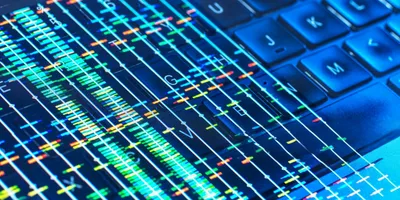CAS, the non-profit division of the American Chemical Society, recently released a report, “Biomaterials: Eight Emerging Areas Reshaping Medicine”, which highlights areas of research poised to revolutionize healthcare, research, and manufacturing.

Angela Zhou, PhD
Angela Zhou
This Q&A with Angela Zhou, PhD, manager of scientific analysis and insights, and Michael Dennis, PhD, chief science officer and vice president, legal at CAS, explores some of the most promising biomaterials, the challenges of scaling production, regulatory hurdles, and the vital role of AI in accelerating development.
Q: Out of the eight areas of biomaterials highlighted in the report, which one(s) excites you most and why?
A: We are excited for all eight of them but favor the bioinks and bioelectronic materials.
Bioinks are biomaterials made from a combination of cells, growth factors, and supportive substances. They enable 3D printing of human tissues and organs. Imagine being able to custom print a bone, cartilage, a piece of a blood vessel, or even an entire organ; then we can replace a malfunctioning body part just like fixing a machine. This ongoing technology, while maturing, could transform healthcare, allowing us to repair malfunctioning body parts with precision. What sounds like science fiction on the surface is not.

Michael Dennis, PhD
Credit: Michael Dennis
Bioelectronic materials are key for creating devices that connect electronics with the body’s natural systems, like cells and organs. These devices combine the body's ability to sense and react to changes with the speed and accuracy of electronics. This opens up many possibilities, such as real-time monitoring of brain activity or heart rate, delivering treatments, and even advanced prosthetics. In the near future, we might all wear devices that track our health, suggest diet changes, and help us balance work, rest, and stress. That would be amazing!
Q: How are laboratories adapting their facilities to accommodate the increased focus on biomaterials research and development?
A: This is a highly collaborative research area that requires close cooperation between biologists, materials scientists, and engineers. Lab facilities will reflect this through a diverse range of equipment and the design of open, collaborative spaces.
For instance, when working with cells or proteins, bio-based materials will often require sterile environments such as cell culture rooms and incubators. Additionally, advanced characterization tools like microscopes, particle size analyzers, and strength testers will be essential for evaluating materials before application. Lastly, simulation tools and robust data management systems will be crucial, supported by advanced computing infrastructure to process and model experimental data efficiently.
Q: What are some of the regulatory challenges laboratories face when working with new biomaterials, and how can lab managers stay compliant while fostering innovation?
A: One regulatory / ethics challenge and opportunity is the ability to use these biomaterials in ways that were not initially intended, like creating bio enhancements or augmentations in humans, such as better organs. Science and technology are outpacing the laws and regulations in many cases today. The legal/ethics side must keep pace with these advancements in biomaterials. Environmental and safety regulations are also a challenge.
This ongoing technology, while maturing, could transform healthcare, allowing us to repair malfunctioning body parts with precision.
Q: What are the key challenges that labs face when scaling up biomaterials production for clinical applications, and how can lab managers mitigate these issues?
A: Lab managers face challenges scaling up biomaterials production, including sterility at scale, which is critical. Additionally, biomaterials are made in part from living cells that require oxygen and other nutrients and the ability to remove waste products. This becomes exponentially more challenging at scale. There is also the cost of specialized facilities and unique fermenters, bio-reactors, and other specialized equipment. The required investments are high, but so are the potential benefits.
Q: How can AI and computational modeling be applied to help progress the development of biomaterials?
A: AI and computational modeling have immense potential in the development of biomaterials. With the astonishing speed at which AI is currently evolving, it is not surprising that these tools are already being used to understand and predict the dynamics of self-healing polymers using image analysis.
Examples range from healing experiments to virtually screening libraries of lipids for use in mRNA-delivery lipid nanoparticles, to modeling the release of drugs from programmable hydrogels in the presence of multiple stimuli, to identifying peptides that have the ability to form hydrogels by combining machine learning with selected experiments. These examples illustrate the potential for AI tools to speed up the development of new biomaterials by processing and extracting information from large data sets and reducing experimental iterations.
Advanced Lab Management Certificate
The Advanced Lab Management certificate is more than training—it’s a professional advantage.
Gain critical skills and IACET-approved CEUs that make a measurable difference.
Angela Zhou is an information scientist at CAS. She earned her PhD in molecular pharmacology and toxicology from University of Southern California. She was further trained as a cell biologist at Johns Hopkins School of Medicine and worked in the area of cancer biology at Harvard Medical School. She was a faculty member at Missouri State University and Denison University prior to joining CAS.
Michael Dennis is responsible for driving the development of the unparalleled CAS scientific content collection and for leading the large CAS scientist team in uncovering insights that accelerate innovation and discovery. He is also responsible for all CAS legal matters, including licensing of intellectual property (IP) and Compliance, Mergers & Acquisitions (M&A) alongside the CAS President and Leadership Team, as well as CAS Community Relations. He is active in the American Chemical Society, American Association for the Advancement of Science, and the American, Ohio, and Columbus Bar Associations. He serves on the National Veterans Memorial and Museum Board, COSI (science museum) Board, Smart Columbus Advisory Board, Juvenile Diabetes Board, One Columbus Leadership Circle, Columbus Rotary, and PAST Foundation (STEM education) Board. He also actively participates in several charitable organizations. Dennis earned his PhD in biochemistry from The Ohio State University and JD from Capital University.













